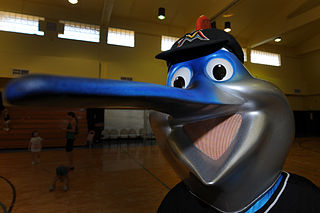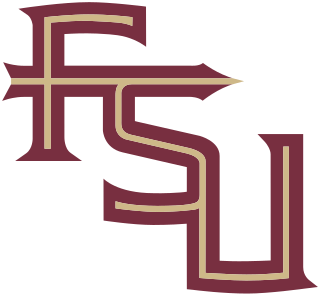
The University of Miami is a private research university in Coral Gables, Florida. As of 2023, the university enrolled 19,593 students in two colleges and eight schools across nearly 350 academic majors and programs, including the Leonard M. Miller School of Medicine in Miami's Health District, the law school on the main campus, the Rosenstiel School of Marine, Atmospheric, and Earth Science on Virginia Key, and additional research facilities in southern Miami-Dade County.

A mascot is any human, animal, or object thought to bring luck, or anything used to represent a group with a common public identity, such as a school, sports team, society, military unit, or brand name. Mascots are also used as fictional, representative spokespeople for consumer products.

The ibis are a group of long-legged wading birds in the family Threskiornithidae that inhabit wetlands, forests and plains. "Ibis" derives from the Latin and Ancient Greek word for this group of birds. It also occurs in the scientific name of the western cattle egret mistakenly identified in 1757 as being the sacred ibis.

The American white ibis is a species of bird in the ibis family, Threskiornithidae. It is found from the southern half of the US East Coast, along the Gulf Coast states and south through most of the Caribbean coastal regions of Central America. This particular ibis species is a medium-sized wading bird, possessing an overall white plumage with black wing-tips, and having the typical downward-curving bill of the ibises, though of a bright red-orange color, the same hue as its long legs. Males are larger and have longer bills than females. The breeding range runs along the Gulf and Atlantic Coast, and the coasts of Mexico and Central America. Outside the breeding period, the range extends further inland in North America and also includes the Caribbean. It is also found along the northwestern South American coastline in Colombia and Venezuela. Populations in central Venezuela overlap and interbreed with the scarlet ibis. The two have been classified by some authorities as a single species.

Chief Illiniwek was the symbol of the University of Illinois Urbana-Champaign (UIUC), associated with the university's intercollegiate athletic programs, from October 30, 1926, to February 21, 2007. Chief Illiniwek was portrayed by a student to represent the Illiniwek, the state's namesake, although the regalia worn was from the Sioux. The student portraying Chief Illiniwek performed during halftime of Illinois football and basketball games, as well as during women's volleyball matches.

The HokieBird is the official mascot of Virginia Polytechnic Institute and State University in Blacksburg, Virginia.

Mark Allan Richt is a retired American football coach, former player, and television analyst. He was the head football coach at the University of Georgia for 15 years and at the University of Miami, his alma mater, for three. His teams won two Southeastern Conference (SEC) championships, five SEC division titles, and one Atlantic Coast Conference (ACC) division title. He was a two-time SEC Coach of the Year, the 2017 ACC Coach of the Year, and the winner of the national 2017 Walter Camp Coach of the Year Award. On January 10, 2023, he was inducted into College Football Hall of Fame as part of the 2023 class.

Gino Louis Torretta is an American former football player who was a quarterback for five seasons in the National Football League (NFL). He played college football for the Miami Hurricanes, where he won the Heisman Trophy in 1992 and was a member of the national championship teams of 1989 and 1991. He was selected by the Minnesota Vikings in the seventh round of the 1993 NFL Draft and was a member of several NFL teams, but never became a regular starter as a pro. He was inducted into the College Football Hall of Fame in 2010.

The Miami Hurricanes football team represents the University of Miami in college football. The Hurricanes compete in the NCAA's Division I Football Bowl Subdivision, the highest level of collegiate football in the nation. The team is a member of the Atlantic Coast Conference, one of the five Power Five conferences in college football. The program began in 1926. Since then, it has since won five AP national championships in 1983, 1987, 1989, 1991, and 2001.

Osceola and Renegade are the official symbols of the Florida State University Seminoles. Osceola, representing the historical Seminole leader Osceola, and his Appaloosa horse Renegade introduce home football games by riding to midfield with a burning spear and planting it in the turf.

Billy the Marlin is the official mascot of the Miami Marlins baseball franchise. At 8 feet tall and 250 pounds, he is "a natural-born clown and good-natured prankster". He appears at every Marlins home game at LoanDepot Park, and performs his own routine in the middle of the 5th inning.
The FIU–Miami football brawl was a bench-clearing brawl that occurred on October 14, 2006, during a college football game between the University of Miami Hurricanes and the Florida International University Golden Panthers at the Miami Orange Bowl in Miami, Florida, United States.

The 1989 Miami Hurricanes football team represented the University of Miami during the 1989 NCAA Division I-A football season. It was the Hurricanes' 64th season of football. The Hurricanes were led by first-year head coach Dennis Erickson and played their home games at the Orange Bowl. They finished the season 11–1 overall. They were invited to the Sugar Bowl where they defeated Alabama, 33–25, to win the school's third national championship.

Cocky is the costumed mascot of the University of South Carolina athletics teams. He represents a cartoon version of a gamecock.

The Miami Hurricanes, known informally as The U,UM, or The 'Canes, are the intercollegiate sports teams that represent the University of Miami in Coral Gables, Florida. The Hurricanes compete in Division I of the National Collegiate Athletic Association, the highest level of collegiate athletics. The University of Miami's football team has won five national championships and its baseball team has won four national championships. Across all sports, the Hurricanes have won 21 national championships and 83 individual national championships.
The 2001 Sugar Bowl was a 2000–01 BCS game played on January 2, 2001. This 67th edition to the Sugar Bowl featured the Florida Gators, and the Miami Hurricanes, in an in-state rivalry game. Miami came into the game ranked 3rd in the BCS, 2nd in both the Coaches and AP Poll, at 10–1, whereas Florida came into the game ranked 7th in the BCS at 10–2. Sponsored by Nokia, the game was officially known as the Nokia Sugar Bowl.

The Florida State–Miami football rivalry is an American college football rivalry between the Florida State Seminoles football team of Florida State University and Miami Hurricanes football team of the University of Miami. Since the late 1980s, one or both squads have been highly ranked entering the game, adding national championship implications to an already heated rivalry. Field goal and PAT kicks have played an important role in the series with many wide right, wide left, blocks and other mistakes occurring with the game in the balance. Miami leads the series 35–33 through the 2023 season.
The Miami Maniac is the official mascot of the Miami Hurricanes baseball program at the University of Miami in Coral Gables, Florida.

The 1989 Florida State Seminoles football team represented Florida State University in the 1989 NCAA Division I-A football season. The team was coached by Bobby Bowden and played their home games at Doak Campbell Stadium.















